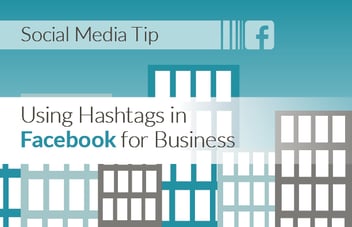Social Media Tip: 7 Basics of Using Hashtags for B2B Marketing
.jpg?width=551&name=Jones_may_blog_headers_social_media_tips%20(1).jpg)
This may come as a surprise to anyone born after 1990, but this symbol (#) has not always been known as a hashtag. It gained that identifier in 2007 when it was introduced by Twitter as a way of identifying and organizing tweets by subject matter.
This may come as a surprise to anyone born after 1990, but this symbol (#) has not always been known as a hashtag. It gained that identifier in 2007 when it was introduced by Twitter as a way of identifying and organizing tweets by subject matter.
Of course, marketers quickly adapted to use it as a way of targeting organic content to reach users across all different social media channels that have adopted it. Today, hashtags are used, in varying strategies, across Twitter, Facebook, Instagram, YouTube, Pinterest and more.
We’ve published a detailed how-to guide to hashtags for business marketing on the blog previously, but here are seven basic guidelines to get you started if you’re new to using them in B2B marketing (or at all).
- A hashtag is written as all one word with the # at the beginning. You can’t include spaces or punctuation. Example: #Covid19 not #Covid 19, and #ImWithHer not #I’mWithHer.
- Use sparingly and with purpose (Instagram is the exception). Don’t use more hashtags than words.
- Don’t use trending hashtags that don’t fit your business or the content just to try to game the algorithms. Just because a certain topic or hashtag is trending doesn’t mean you should try to use it if it doesn’t make sense.
- Follow the rules and guidelines of each channel. You will want to take a different approach to Instagram than you do to LinkedIn. Don’t just post the same thing everywhere.
- Hashtags aren’t a substitute for well written copy and quality images. Hashtags may help you get some exposure for your content, but the content still needs to be worth the readers’ time.
- Use your analytics from your social media channels to identify which hashtags are getting the most traction and/or leading to higher click-through-rates to your website or on other calls-to-action. Focus on what works for your pages to achieve your goals.
- Stay on brand. Remember that the hashtags you use are an extension of your brand identity. Maintaining a consistent identity and image is important whether you are a B2C targeting young customers with an edgy vibe or a B2B trying to reach executives with an image of cutting-edge research or reliability and expertise.
Hashtags should be a part of your social media strategy, whether you are marketing B2C or B2B products or services. Consider them carefully, use them intentionally, and target them to the audiences and topics most relevant to your brand.
Used well, hashtags can help your organic social media content target those users most interested in your product or services. Learn how one JONES client used organic content—not paid advertising—to increase their social media reach by 12 times its previous level in a single month of consistent posting. Download the case study today.
If you are looking for more than a few tips and need a partner to develop and implement a complete content marketing strategy that includes more than just social media, schedule a time for a no-obligation consultation and let’s chat.
-1.png?width=1652&height=294&name=Jones(RGB)-1.png)

.jpg)








%20-%20Header.jpg?width=352&name=What%20Makes%20B2B%20Marketers%20Tick%20in%202022%20(infographic)%20-%20Header.jpg)

